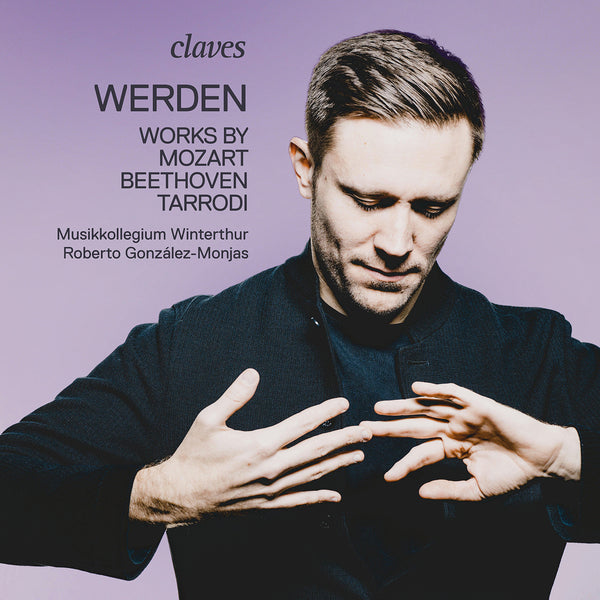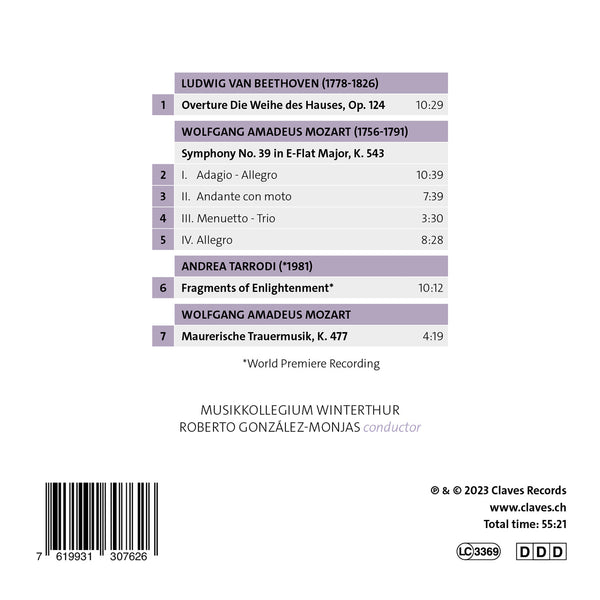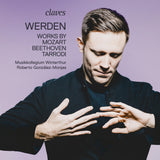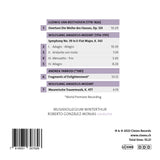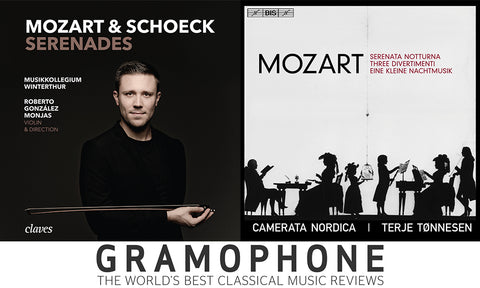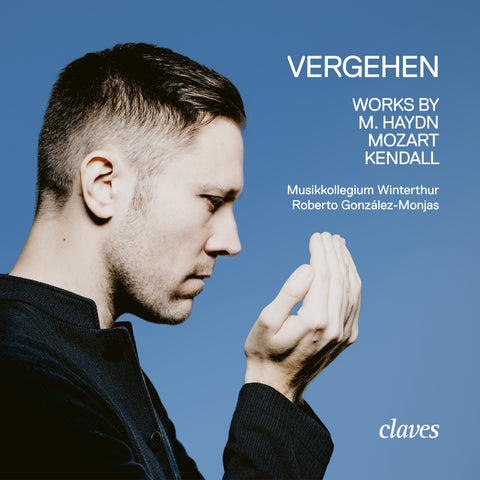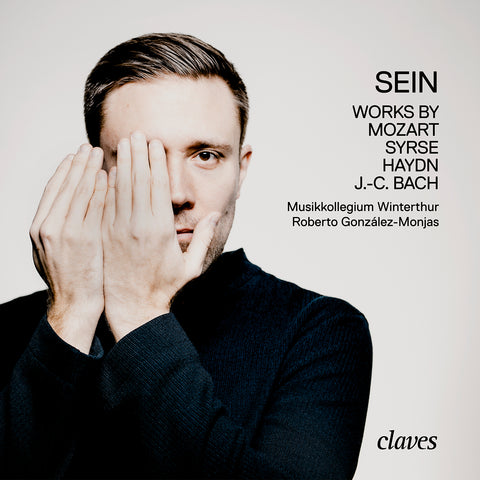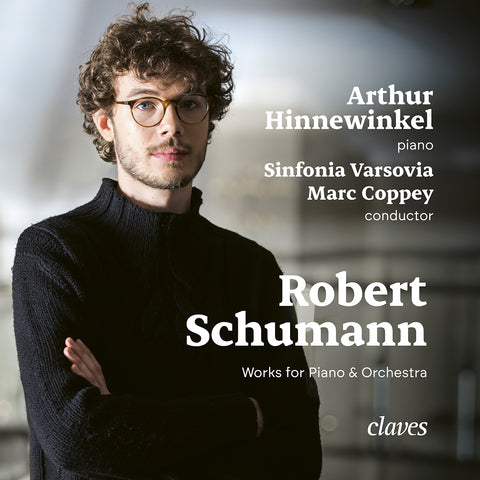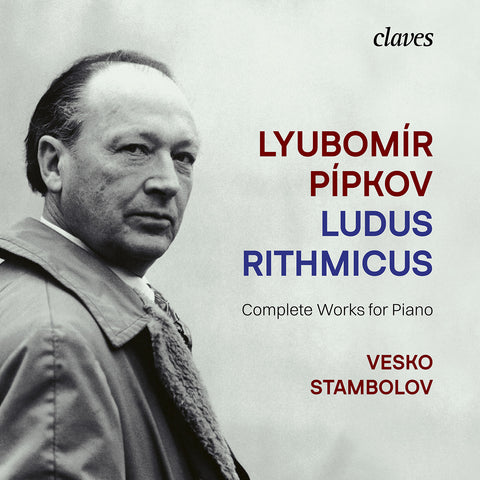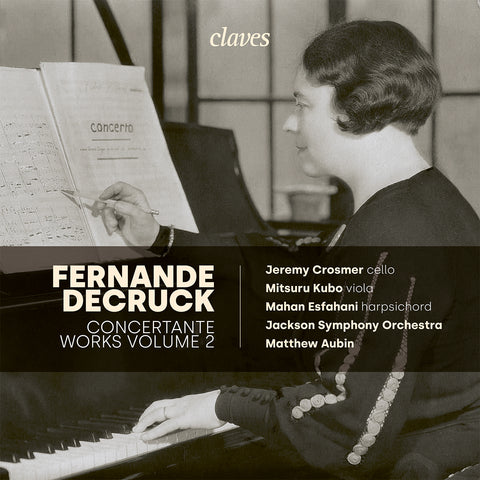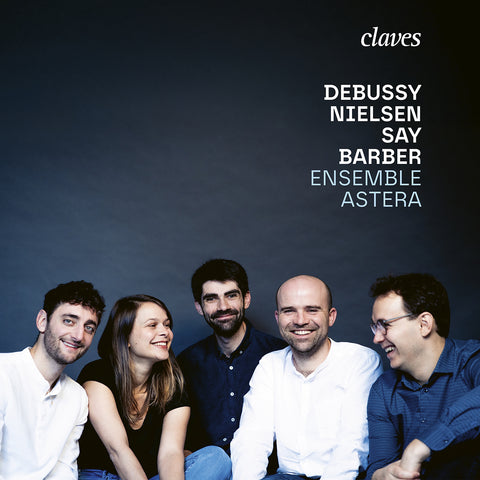(2023) «Werden» works by Mozart - Beethoven - Tarrodi
Category(ies): Modern Orchestra Repertoire
Main Composer: Various composers (see collections)
Orchestra: Musikkollegium Winterthur
Conductor: Roberto González-Monjas
CD set: 1
Catalog N°:
CD 3076
Release: 30.06.2023
EAN/UPC: 7619931307626
This album is now on repressing. Pre-order it at a special price now.
CHF 18.50
This album is no longer available on CD.
This album has not been released yet. Pre-order it from now.
CHF 18.50
This album is no longer available on CD.
CHF 18.50
VAT included for Switzerland & UE
Free shipping
This album is no longer available on CD.
VAT included for Switzerland & UE
Free shipping
This album is now on repressing. Pre-order it at a special price now.
CHF 18.50
This album is no longer available on CD.
This album has not been released yet.
Pre-order it at a special price now.
CHF 18.50
This album is no longer available on CD.
CHF 18.50
This album is no longer available on CD.
«WERDEN» WORKS BY MOZART - BEETHOVEN - TARRODI
ROBERTO GONZÁLEZ-MONJAS ON MOZART’S SPLENDID SYMPHONY NO. 39
“Even if you don’t have to understand music completely, it’s fascinating to unlock the secrets behind musical masterpieces.”
The theme of our 22/23 season, “Werden” (Becoming), is taken directly from Mozart’s splendid Symphony No. 39. This work is associated with concepts such as freemasonry, virtuosity, nature, mystery and enlightenment. But why? Can music really express these ideas, or do we merely randomly associate romantic meanings with it? How can we interpret a manuscript – hastily written in ink on parchment by candlelight in 1788? I warmly invite you to engage with the hidden aspects of this fascinating work.
ANDREA TARRODI ON FRAGMENTS OF ENLIGHTENMENT
I was commissioned to compose “Fragments of Enlightenment” by the Musikkollegium Winterthur and its Chief Conductor Roberto González-Monjas. It is inspired by Mozart’s Symphony No. 39, and there are quotes and fragments from his work throughout the piece. When composing, I thought of someone who is struggling inwardly, constantly striving for light and serenity – values for which Mozart’s music often stands. It is for the listener to decide whether he or she finds these at the end of the piece.
Andrea Tarrodi
WOLFGANG AMADEUS MOZART SYMPHONY NO. 39 IN E-FLAT MAJOR
Mozart’s symphony in E-flat major begins with a grand gesture. At the same time, it opens the mythical “triad” of last symphonies that Mozart penned at seemingly superhuman speed in the summer of 1788. Three times, at the beginning of the long introduction, our attention is aroused – with pathos, pearly descending scales and dotted rhythms in accordance with the ceremonial of the French overture. Timpani and trumpets reinforce the sublime tone which, however, does not remain without strong contrasts over the course of the symphony. The perpetuum mobile finale à la Haydn, in particular, comes to such a sudden halt that, in the words of Hans Georg Nägeli, “the unprepared listener has no idea what is happening to him” . According to musicologist Peter Gülke, this abrupt end to the work could perhaps also be understood as a provisional conclusion in the midst of the symphonic triad.
Tiziana Gohl
WOLFGANG AMADEUS MOZART MAURERISCHE TRAUERMUSIK
As a result of Joseph II’s relaxation of censorship, masonic lodges with a need for ritual, sacred music mushroomed in Vienna in the 1780s. Since joining the “Zur Wohltätigkeit” lodge at the end of 1784, Wolfgang Amadeus Mozart had composed numerous works connected with freemasonry. The genesis of the “Masonic Funeral Music” and the reason for its creation are not without controversy. An initial setting, dated by Mozart to July 1785, may have served as the accompaniment for the ritual elevation of an initiate to the rank of master. For a later version, which was probably performed at the funeral service of two important lodge brothers in December of the same year, Mozart gave the piece greater depth by adding two basset horns and an octave bassoon. Set in C minor, the traditional key of mourning, the melancholy movement begins with the lamentation of the plaintive minor second in the oboes. For the consoling middle section in E-flat major, Mozart used a cantus firmus – a set melody – taken from the Good Friday liturgy, just as Johann Michael Haydn had done for his Requiem, which Mozart knew and appreciated.
Severin Kolb
LUDWIG VAN BEETHOVEN OVERTURE DIE WEIHE DES HAUSES
October 3, 1822, marked a memorable new beginning: after a period of rebuilding, Vienna’s Theater in der Josefstadt was due to reopen. The overture for the festivities was composed and conducted by Ludwig van Beethoven, notwithstanding his advanced hearing affliction – the only theatre to have been “consecrated” by the composer himself, performing a work of his own composition. The introduction of this “occasional piece” already strikes a majestic tone, before a trumpet fanfare resounds for the transition into the main movement. A solemn fugato, paired with the instruction “Allegro con brio” – significant for Beethoven – creates an especially festive atmosphere. The radiant coda in C major elevates this key to veritably panegyric heights. The fact that Beethoven later included the overture in the concert programme for the première of his Ninth Symphony, together with excerpts from the Missa solemnis, illustrates its significance for his orchestral music. Contemporaries considered it “indisputably among Beethoven’s most accomplished works” .
Tiziana Gohl
Translations: Toby Alleyne-Gee
ROBERTO GONZÁLEZ-MONJAS
Roberto González-Monjas is an extremely sought-after conductor and violinist who has rapidly established an international reputation. He is Chief Conductor of the Musikkollegium Winterthur as well as Chief Conductor and Artistic Adviser of the Dalasinfoniettan. He is also Principal Guest Conductor of the Belgian National Orchestra, and is designate Music Director of the Galicia Symphony Orchestra in Spain, starting in September 2023. As a committed educator, Roberto González-Monjas founded the Iberacademy together with conductor Alejandro Posada in 2013.
The institution aims to create an efficient and sustainable model of musical education in Latin America that focuses on disadvantaged sections of the population – as well as promoting highly talented young musicians. Roberto González-Monjas was recently appointed Chief Conductor of the Mozarteumorchester Salzburg, where his tenure will begin in September 2024. González- Monjas is also Professor of Violin at the Guildhall School of Music & Drama and is a regular mentor and conductor of the Guildhall School Chamber and Symphony Orchestra at London’s Barbican Hall.
Roberto González-Monjas was previously Concertmaster of the Orchestra dell’Accademia Nazionale di Santa Cecilia for six years and First Concertmaster of the Musikkollegium Winterthur until the end of the 2020/21 season.
MUSIKKOLLEGIUM WINTERTHUR
The Musikkollegium Winterthur was founded in 1629 and thus boasts one of the longest-standing traditions among Europe’s musical institutions.
Winterthur occupies a prominent position in Europe’s cultural landscape. This is due not only to its art collections, but also to its orchestra – the Musikkollegium Winterthur – which has been under the direction of Chief Conductor Roberto González-Monjas since 2021/22. The history of the Musikkollegium Winterthur, which stretches back to 1629, is still very much alive: today, the dedication of Winterthur’s bourgeois families of the 17th century is maintained by the numerous members of the orchestra association. The early 20th century was a particularly formative period, with patron of the arts Werner Reinhart and conductor Hermann Scherchen transforming Winterthur into a centre of European musical life. Igor Stravinsky, Richard Strauss and Anton Webern all frequented the city, as did Clara Haskil and Wilhelm Furtwängler.
This is a legacy that comes with obligations: no other classical symphony orchestra in Switzerland devotes itself to contemporary music with as much natural confidence as the Musikkollegium Winterthur. World premières also feature on the programme – most recently of works by composers such as Richard Dubugnon, Helena Winkelman and David Philip Hefti. The orchestra’s remaining repertoire focuses on the classical and early romantic periods. However, the agile ensemble also likes to shed fresh light on great symphonic works, such as those by Brahms, who is the subject of a recent CD recording. The orchestra can also be regularly experienced in opera and ballet productions. With more than 40 concerts per season, a versatile musical education programme and interdisciplinary formats, the Musikkollegium Winterthur is an outstanding ensemble.
Many have contributed to the high quality of the orchestra’s performances: former chief conductors such as Franz Welser-Möst, Heinrich Schiff or Thomas Zehetmair, long-standing guest conductors such as Heinz Holliger, Reinhard Goebel and Michael Sanderling, but also internationally sought-after soloists, who always enjoy returning to the Musikkollegium Winterthur. Andreas Ottensamer, Barbara Hannigan, Sir András Schiff, Ian Bostridge and Carolin Widmann, among others, regularly give guest performances in Winterthur.
REVIEWS
"Dank González-Monjas erlebt das Musikkollegium Winterthur einen Höhenflug." - Michael Graber, Dezember 2024
« Werden – Sein – Vergehen: ein Triptychon à la Segantini mit Mozarts letzten drei Sinfonien schwebt den Winterthurern vor, flankiert von zeitgenössischer Musik und weiteren Werken aus Mozarts Zeit, die zeitlich oder thematisch passen. Die Nummer 39 segelt damit unter «Werden», und der Chef am Pult, Roberto Gonzáles-Monjas, deutet sie als menschliches Streben zu Licht und Aufklärung, Selbstbestimmtheit und Erleuchtung, und unterstreicht das mit viel Brio, Streicherglanz und vorwärtsdrängender Gestik. [..] » - Reinmar Wagner, Dezember 2023
“Roberto González-Monjas opens the exciting program with five striking chord strokes. Beethoven’s overture ‘The Consecration of the House’ musically points to something new. This music sounds solemn, self-confident – in the age of enlightenment, of revolutions, old customs are cut off. [..] With this album, an exciting trilogy is indeed in the making.” - Guy Engels, July 2023
"[..] In this new album too, the orchestra displays its great qualities through a playing culture that offers a fine blend of tradition (without ever becoming the Mozartian style of a Bruno Walter) and history (contrast, rhythmic profile, short phrases). The clarinettist's (non-prescribed) ornamentation in the repetition of the trio is very seductive. The fact that Beethoven's ‘Die Weihe des Hauses’ overture, uninspired and clearly a makeshift work cobbled together in a hurry, is made of thick wooden planks, can't do this orchestra and its conductor any harm either. [..]" - Aart van der Wal, June 2023
ROBERTO GONZÁLEZ-MONJAS ON MOZART’S SPLENDID SYMPHONY NO. 39
“Even if you don’t have to understand music completely, it’s fascinating to unlock the secrets behind musical masterpieces.”
The theme of our 22/23 season, “Werden” (Becoming), is taken directly from Mozart’s splendid Symphony No. 39. This work is associated with concepts such as freemasonry, virtuosity, nature, mystery and enlightenment. But why? Can music really express these ideas, or do we merely randomly associate romantic meanings with it? How can we interpret a manuscript – hastily written in ink on parchment by candlelight in 1788? I warmly invite you to engage with the hidden aspects of this fascinating work.
ANDREA TARRODI ON FRAGMENTS OF ENLIGHTENMENT
I was commissioned to compose “Fragments of Enlightenment” by the Musikkollegium Winterthur and its Chief Conductor Roberto González-Monjas. It is inspired by Mozart’s Symphony No. 39, and there are quotes and fragments from his work throughout the piece. When composing, I thought of someone who is struggling inwardly, constantly striving for light and serenity – values for which Mozart’s music often stands. It is for the listener to decide whether he or she finds these at the end of the piece.
Andrea Tarrodi
WOLFGANG AMADEUS MOZART SYMPHONY NO. 39 IN E-FLAT MAJOR
Mozart’s symphony in E-flat major begins with a grand gesture. At the same time, it opens the mythical “triad” of last symphonies that Mozart penned at seemingly superhuman speed in the summer of 1788. Three times, at the beginning of the long introduction, our attention is aroused – with pathos, pearly descending scales and dotted rhythms in accordance with the ceremonial of the French overture. Timpani and trumpets reinforce the sublime tone which, however, does not remain without strong contrasts over the course of the symphony. The perpetuum mobile finale à la Haydn, in particular, comes to such a sudden halt that, in the words of Hans Georg Nägeli, “the unprepared listener has no idea what is happening to him” . According to musicologist Peter Gülke, this abrupt end to the work could perhaps also be understood as a provisional conclusion in the midst of the symphonic triad.
Tiziana Gohl
WOLFGANG AMADEUS MOZART MAURERISCHE TRAUERMUSIK
As a result of Joseph II’s relaxation of censorship, masonic lodges with a need for ritual, sacred music mushroomed in Vienna in the 1780s. Since joining the “Zur Wohltätigkeit” lodge at the end of 1784, Wolfgang Amadeus Mozart had composed numerous works connected with freemasonry. The genesis of the “Masonic Funeral Music” and the reason for its creation are not without controversy. An initial setting, dated by Mozart to July 1785, may have served as the accompaniment for the ritual elevation of an initiate to the rank of master. For a later version, which was probably performed at the funeral service of two important lodge brothers in December of the same year, Mozart gave the piece greater depth by adding two basset horns and an octave bassoon. Set in C minor, the traditional key of mourning, the melancholy movement begins with the lamentation of the plaintive minor second in the oboes. For the consoling middle section in E-flat major, Mozart used a cantus firmus – a set melody – taken from the Good Friday liturgy, just as Johann Michael Haydn had done for his Requiem, which Mozart knew and appreciated.
Severin Kolb
LUDWIG VAN BEETHOVEN OVERTURE DIE WEIHE DES HAUSES
October 3, 1822, marked a memorable new beginning: after a period of rebuilding, Vienna’s Theater in der Josefstadt was due to reopen. The overture for the festivities was composed and conducted by Ludwig van Beethoven, notwithstanding his advanced hearing affliction – the only theatre to have been “consecrated” by the composer himself, performing a work of his own composition. The introduction of this “occasional piece” already strikes a majestic tone, before a trumpet fanfare resounds for the transition into the main movement. A solemn fugato, paired with the instruction “Allegro con brio” – significant for Beethoven – creates an especially festive atmosphere. The radiant coda in C major elevates this key to veritably panegyric heights. The fact that Beethoven later included the overture in the concert programme for the première of his Ninth Symphony, together with excerpts from the Missa solemnis, illustrates its significance for his orchestral music. Contemporaries considered it “indisputably among Beethoven’s most accomplished works” .
Tiziana Gohl
Translations: Toby Alleyne-Gee
ROBERTO GONZÁLEZ-MONJAS
Roberto González-Monjas is an extremely sought-after conductor and violinist who has rapidly established an international reputation. He is Chief Conductor of the Musikkollegium Winterthur as well as Chief Conductor and Artistic Adviser of the Dalasinfoniettan. He is also Principal Guest Conductor of the Belgian National Orchestra, and is designate Music Director of the Galicia Symphony Orchestra in Spain, starting in September 2023. As a committed educator, Roberto González-Monjas founded the Iberacademy together with conductor Alejandro Posada in 2013.
The institution aims to create an efficient and sustainable model of musical education in Latin America that focuses on disadvantaged sections of the population – as well as promoting highly talented young musicians. Roberto González-Monjas was recently appointed Chief Conductor of the Mozarteumorchester Salzburg, where his tenure will begin in September 2024. González- Monjas is also Professor of Violin at the Guildhall School of Music & Drama and is a regular mentor and conductor of the Guildhall School Chamber and Symphony Orchestra at London’s Barbican Hall.
Roberto González-Monjas was previously Concertmaster of the Orchestra dell’Accademia Nazionale di Santa Cecilia for six years and First Concertmaster of the Musikkollegium Winterthur until the end of the 2020/21 season.
MUSIKKOLLEGIUM WINTERTHUR
The Musikkollegium Winterthur was founded in 1629 and thus boasts one of the longest-standing traditions among Europe’s musical institutions.
Winterthur occupies a prominent position in Europe’s cultural landscape. This is due not only to its art collections, but also to its orchestra – the Musikkollegium Winterthur – which has been under the direction of Chief Conductor Roberto González-Monjas since 2021/22. The history of the Musikkollegium Winterthur, which stretches back to 1629, is still very much alive: today, the dedication of Winterthur’s bourgeois families of the 17th century is maintained by the numerous members of the orchestra association. The early 20th century was a particularly formative period, with patron of the arts Werner Reinhart and conductor Hermann Scherchen transforming Winterthur into a centre of European musical life. Igor Stravinsky, Richard Strauss and Anton Webern all frequented the city, as did Clara Haskil and Wilhelm Furtwängler.
This is a legacy that comes with obligations: no other classical symphony orchestra in Switzerland devotes itself to contemporary music with as much natural confidence as the Musikkollegium Winterthur. World premières also feature on the programme – most recently of works by composers such as Richard Dubugnon, Helena Winkelman and David Philip Hefti. The orchestra’s remaining repertoire focuses on the classical and early romantic periods. However, the agile ensemble also likes to shed fresh light on great symphonic works, such as those by Brahms, who is the subject of a recent CD recording. The orchestra can also be regularly experienced in opera and ballet productions. With more than 40 concerts per season, a versatile musical education programme and interdisciplinary formats, the Musikkollegium Winterthur is an outstanding ensemble.
Many have contributed to the high quality of the orchestra’s performances: former chief conductors such as Franz Welser-Möst, Heinrich Schiff or Thomas Zehetmair, long-standing guest conductors such as Heinz Holliger, Reinhard Goebel and Michael Sanderling, but also internationally sought-after soloists, who always enjoy returning to the Musikkollegium Winterthur. Andreas Ottensamer, Barbara Hannigan, Sir András Schiff, Ian Bostridge and Carolin Widmann, among others, regularly give guest performances in Winterthur.
REVIEWS
"Dank González-Monjas erlebt das Musikkollegium Winterthur einen Höhenflug." - Michael Graber, Dezember 2024
« Werden – Sein – Vergehen: ein Triptychon à la Segantini mit Mozarts letzten drei Sinfonien schwebt den Winterthurern vor, flankiert von zeitgenössischer Musik und weiteren Werken aus Mozarts Zeit, die zeitlich oder thematisch passen. Die Nummer 39 segelt damit unter «Werden», und der Chef am Pult, Roberto Gonzáles-Monjas, deutet sie als menschliches Streben zu Licht und Aufklärung, Selbstbestimmtheit und Erleuchtung, und unterstreicht das mit viel Brio, Streicherglanz und vorwärtsdrängender Gestik. [..] » - Reinmar Wagner, Dezember 2023
“Roberto González-Monjas opens the exciting program with five striking chord strokes. Beethoven’s overture ‘The Consecration of the House’ musically points to something new. This music sounds solemn, self-confident – in the age of enlightenment, of revolutions, old customs are cut off. [..] With this album, an exciting trilogy is indeed in the making.” - Guy Engels, July 2023
"[..] In this new album too, the orchestra displays its great qualities through a playing culture that offers a fine blend of tradition (without ever becoming the Mozartian style of a Bruno Walter) and history (contrast, rhythmic profile, short phrases). The clarinettist's (non-prescribed) ornamentation in the repetition of the trio is very seductive. The fact that Beethoven's ‘Die Weihe des Hauses’ overture, uninspired and clearly a makeshift work cobbled together in a hurry, is made of thick wooden planks, can't do this orchestra and its conductor any harm either. [..]" - Aart van der Wal, June 2023
Return to the album | Read the booklet | Open online links | Composer(s): Various composers | Main Artist: Roberto González Monjas
STUDIO MASTER (HIGH-RESOLUTION AUDIO)
Andrea Tarrodi (*1981)
High-resolution audio - Studio master quality
In stock
Ludwig van Beethoven (1778-1826)
Modern
Musikkollegium Winterthur
New releases
Orchestra
Pizzicato.lu - Supersonic
Repertoire
Roberto González-Monjas - conductor
Various composers
Wolfgang Amadeus Mozart (1756-1791)
World Premiere Recording
Andrea Tarrodi (*1981)
High-resolution audio - Studio master quality
In stock
Ludwig van Beethoven (1778-1826)
Modern
Musikkollegium Winterthur
New releases
Orchestra
Pizzicato.lu - Supersonic
Repertoire
Roberto González-Monjas - conductor
Various composers
Wolfgang Amadeus Mozart (1756-1791)
World Premiere Recording






